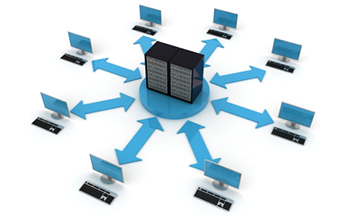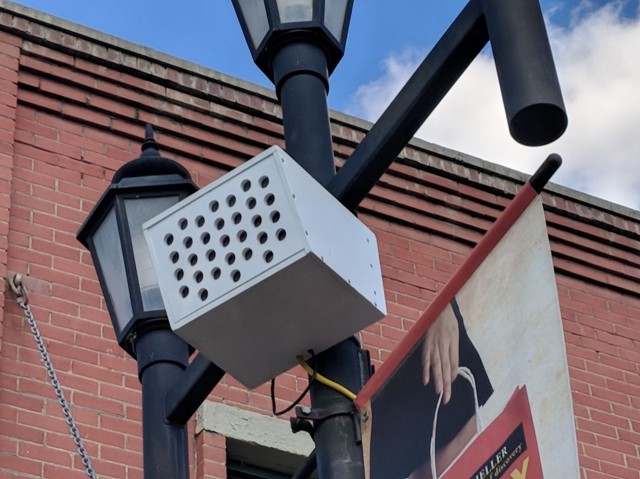The Challenge!
In approx. 2016 we were approached by Bob Sheddy of Century 21. He had a vision and a dream of being able to play music throughout the downtown business district. This dream was the inspiration that kicked off a two year planning phase in which several solutions were investigated and discarded as they did not meet the key requirements laid out below.
- The system had to be easy to maintain, we were not going to have paid staff to manage it
- We needed to be able to control the music content easily, for special events and special holidays
- We needed to stay within a tight budget, getting most of the equipment through sponsorship and/or donation
Some of the discarded solutions and challenges were; a low powered FM broadcast, a wired speaker system, various wireless systems for broadcast, other Wi-Fi speaker solutions, and ways to power up the devices. There were pros and cons to each method, but in the end, we settled on a fairly high-tech solution that was reliable and also extremely cost effective.
Local Business Support was KEY!!
None of this would have been possible without the support of local businesses, who helped cover the majority of the costs associated with this project. All of the capital and ongoing costs for Internet services, and music content were donated by local businesses.
Local Businesses who have sponsored/donated:
Reality Bytes Incorporated / BYTEsurfer Communications – WiFi & Internet sponsor, SONOS Connect Sponsor, Installation & Ongoing Support donated, power & cabling costs, network & Internet equipment donated
Bob Sheddy / Century 21 – TWO Speaker Sponsor
Drumheller Chiropractic Clinic – Speaker Sponsor
Napier Theatre – Speaker Sponsor
3rd Avenue Arts – Speaker Sponsor
Ascend Financial – Speaker Sponsor
Drumheller Chamber of Commerce – TWO Speaker Sponsor
The Brick Drumheller – Speaker Sponsor
Clarity Cannabis Solutions – Speaker Sponsor
Western GM Drumheller – Plaza Speaker Sponsor
We would also like to give a gracious thank you to the Town of Drumheller for providing access to the street lamp posts, and their assistance with the SOCAN licensing.
Here’s how we built a professional quality sound and Wi-Fi system on a tight budget!!
For the those of you who are into lists, we used:
- Sonos Speakers
- Custom built speaker enclosures
- Ubiquiti Commercial WiFi Access Points
- Mikrotik routing technology with a custom layer 2 network
- Multiple Internet access locations
- Various strategic locations outdoors throughout the downtown core
- Virtual Machine technology & Tablet/Mobile devices
- Google Play Music
- LIVE broadcasting capabilities using a Sonos Connect
- Lots of creativity, outside the box thinking, and automation rules
- A HUGE partnership with the local business community
Speakers
We are utilizing Sonos Play 3 (and soon some Play 5) speakers as the primary speaker solution. The Sonos platform is ever expanding and works with common automation technologies such as IFTTT (IF This, Then That), allows for scheduling of on/off and several other automation factors. It’s also a rock solid and proven technology.
Sonos speakers run on a layer 2 IP network, either wired or wireless through WiFi. They cannot interact with each other if multiple separate network subnets exist, or if there is any layer 3 routing involved. This made for another challenge…. How do we create a “flat” layer 2 network so that all the Sonos speakers can see and talk to one another when they are not in the same room, or even the same building?
Protecting the Speakers / Outdoor Enclosures
The SONOS speakers, while very resilient, are NOT fully outdoor rated speakers. This meant designing a custom enclosure for them to protect from the elements, while also protecting them from vandalism and theft. We researched a few options for pre-built manufactured enclosures and ordered one in as a prototype. We really were not happy with the design though, and it wasn’t all that exceptionally strong. So, we designed our own custom enclosure using “puck board” as the material. Puck board is the same product on the sides of the hockey rink! It’s very strong, provides a weatherproof and vandal proof enclosure, and because these enclosures were fabricated by a local contractor, we were able to design them to our specification.
Wi-Fi Solution
We utilized a WiFi MESH technology from Ubiquiti Networks, (or UBNT for short) and, co-located the WiFi Access Points to be at each speaker location. This allowed for two things, one being that we had stable and fast network access for the SONOS speaker system, and two being that we could provide a separate “public wifi” service to people walking throughout the downtown core. Providing free WiFi for visitors to the area is an economic driver for the whole downtown, and statistically causes visitors to stay a bit longer downtown, which in turn translates to increased traffic, and increased business for the downtown area. We really felt it was important to incorporate a free outdoor WiFi into the project, and we were able to do this for essentially ZERO additional costs!
IPv4 Networks and Routing
As we mentioned earlier in the article, the SONOS speakers are truly designed for a whole home music solution, not for spreading across several square kilometres! SONOS speakers need to “believe” that they are all on the same layer 2 network, basically what everyone has in their home. So, again we went on a outside the box brainstorming session, and we came up with an idea to tie multiple “core” locations together using a EoIP tunnel. Layer 2 networks need to be “flat” as if they are all on the same router/switch. This is where EoIP tunnelling comes in to play. We utilized a cost-effective router model from Mikrotik that has this featureset. A separate VLAN, and subnet was setup on the core WiFi network for the outdoor speakers, and then an EoIP (Ethernet over IP) tunnel system was created between the multiple segments of the network.
DHCP services were provided by the Mikrotik from the core BYTEsurfer.ca network at Reality Bytes, along with DNS resolution, and Internet access.
Internet Access
Reality Bytes provides Internet services throughout the entire Drumheller area under the brand “BYTEsurfer Communications.” They donated Internet service costs, and all Internet equipment to the project at the several jump point locations.
Ongoing Internet access costs are also fully donated by Reality Bytes. In addition to providing Internet access for streaming audio content, the Reality Bytes’ BYTEsurfer network also delivers reliable and high speed Internet to the other VLANs for Public WiFi.
Locations
The Town of Drumheller was contacted to get their permission to locate the speaker enclosure and WiFi MESH Points on the Town’s streetlight poles. We felt this would look the best aesthetically, and also give a consistent volume level whenever possible. In certain locations, we were able to get permission from the business, or building owner, to mount the speaker and WiFi MESH point directly to their building, or on a non penetrating roof mount where street light poles did not exist.
We also asked about the possibility of using the street light poles to power up the speakers themselves. While they are quite low power usage devices, they still need some way to get powered up. Unfortunately, for “phase 1” we could not utilize the street light poles and had to incur the additional expense of running power cords to wherever we could “find” power (with permission of course). However, in “phase 2” of this project, the speakers will be powered directly off the street light poles themselves. (The Town of Drumheller is planning a replacement of the street lights some time in 2019, and with that the new poles will have the added benefit of a power outlet for us to utilize)
Playing the content. Tablet vs Virtual Machine
SONOS has an easy to use and intuitive app for both Apple (iOS) and Google (Android) platforms. They also have a desktop software that runs on Microsoft Windows. Initially we ran the entire project off an iPad (also donated by Reality Bytes) and this worked decently, but the issue was that the iPad needed to be attached to the WiFi to communicate with the speakers.
To counteract this, we decided to build a virtual machine hosted on the Reality Bytes Cloud Hosting infrastructure, allowing the VM to be directly tied to the network at all times, and for us to be able to remote into the virtual machine whenever needed to make adjustments. Reality Bytes graciously donated the full costs of building, hosting, and supporting a Microsoft Windows 10 virtual machine on their cloud platform.
Streaming the Audio Content
We decided to utilize Google Play streaming music services to provide 100% ad free audio content that we can schedule and sort of “set and forget”. Google charges a monthly fee for this, and Reality Bytes is also donating this ongoing fee to the cause.
Because this is a public audio broadcast, the audio in the streets needs to be licensed through SOCAN. We approached the Town of Drumheller to assist with this for multiple reasons. They technically “own” the street so the license needed to be in their name, and they already had a SOCAN license in place for the Badlands Community Facility. The Town of Drumheller graciously assisted in this, and we very much thank them for being a partner in the project.
LIVE Broadcasting
Shortly after getting the music content playing, it was brought up several times to us that it sure would be nice to use the speakers for special events. We had a plan for this contingency. SONOS developed a product called the “SONOS Connect”. The SONOS Connect device plugs into power, auto connects to the WiFi network for the Outdoor Music, and allows for a live broadcast to push to the speakers. This is really handy for special events, and other times where you may want to have a person speaking on a microphone, or a live music event downtown. And, because the SONOS connect utilizes the MESH WiFi technology, it can be connected anywhere in the downtown core!
IT Automation Systems
We have compiled an automation schedule that auto starts the music and auto stops the music each day. This ensures that the music isn’t left playing overnight, and because it is fully automated, it just happens, without any human interaction. Also, because the platform we have designed is compatible with open automation standards such as IFTTT (IF This Than That) we can integrate TONS of other automation rules in the future. We could tie this system to a Google Home AI speaker, smart lighting technology, Amazon Alexa, just about ANY sort of custom automation can be achieved down the road.
The story continues….
As we add and expand on the speaker network, we’ll be updating this blog post with more information and details. So check back for further information anytime!
Interested??
Would you like a custom solution such as this for your community, business, or college campus? Reality Bytes can partner with your IT department to deploy and maintain this type of system anywhere in North America. For more information please contact Reality Bytes.





